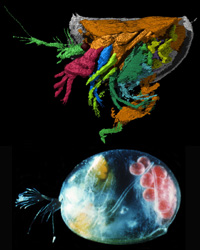Recently, geologists made a stunning discovery: hard boiled eggs that are over 425 million years old! The scientists, who are from the USA and the UK, discovered a female from a new ostracod species, Nymphatelina gravida -- a minute relative of the shrimp -- complete with a brood of approximately 20 eggs and 2 possible juveniles inside her body. Other parts of her soft anatomy were also preserved, including legs and eyes.
"Ostracods are common, pin-head sized crustaceans known from thousands of living species in garden ponds to oceans and from countless fossil shells up to 500 million years old," said David Siveter from the Department of Geology at the University of Leicester, UK, and chairman of the Micropalaeontological Society. "However, their fossilized soft-parts are exceedingly rare."
 The female ostracod (digital image pictured, top of the image at the right) was exquisitely preserved three-dimensionally in volcanic ash.
The female ostracod (digital image pictured, top of the image at the right) was exquisitely preserved three-dimensionally in volcanic ash.
"Supposed examples of fossil invertebrate eggs are also few," continued Siveter. "The fossil we have found contains soft-part anatomy such as legs and eyes and also includes about twenty eggs, each about half a millimeter in size, and two possible juveniles."
The image at the right shows this fossil arthropod with her shell removed, and is color-coded to reveal appendages (red, green and blue) and eggs (yellow), and is compared to a modern relative from the Atlantic Ocean (pictured, below in the same figure).
The scientists named thisl fossil "Nymphatelina gravida", meaning "a pregnant young woman of the sea".
"This remarkable discovery provides an unequivocal and unique view of parental brood care in the invertebrate fossil record,"observed Siveter. "It allows gender to be determined in an animal as old as the Silurian period of geological time, and indicates a remarkably conserved egg brooding reproductive strategy."
The research team was led by David Siveter and consisted of Derek Briggs from Yale University who was the lead author of the paper, and Derek Siveter and Mark Sutton from the University of Oxford. These findings have been published online in the peer-reviewed scientific journal, Proceedings of the Royal Society.
.
Sources
Press release (image, quotes)

These images gratify me as I recall talking to invertebrate paleontologists about how difficult it is to deal with fossil-ostracode taxonomy since appendages have been made the traditional basis of classifying living forms. I suppose many modern species will turn out to have sibling species hidden within once it is economical to analyze their DNA
I'm glad something like it was discovered. This only prove that fossilized boiled egg do exist, and further support my claim of one i had at hand.